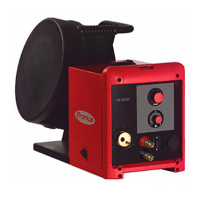Specific hazards Keep hands, hair, clothing and tools away from moving parts. For example:
-
Fans
-
Cogs
-
Rollers
-
Shafts
-
Wire spools and welding wires
Do not reach into the rotating cogs of the wire drive or into rotating drive com-
ponents.
Covers and side panels must only be opened/removed while maintenance or re-
pair work is being carried out.
During operation
-
Ensure that all covers are closed and all side panels are fitted properly.
-
Keep all covers and side panels closed.
Welding wire emerging from the welding torch poses a high risk of injury (piercing
of the hand, injuries to the face and eyes, etc.)
Therefore, always keep the welding torch away from the body (devices with
wirefeeder) and wear suitable protective goggles.
Never touch the workpiece during or after welding - risk of burns.
Slag can jump off cooling workpieces. The specified protective equipment must
therefore also be worn when reworking workpieces, and steps must be taken to
ensure that other people are also adequately protected.
Welding torches and other parts with a high operating temperature must be al-
lowed to cool down before handling.
Special provisions apply in areas at risk of fire or explosion
- observe relevant national and international regulations.
Welding systems for work in areas with increased electrical risk (e.g. near boilers)
must carry the ‘Safety’ sign. However, the welding system must not be located in
such areas.
Risk of scalding from escaping coolant. Switch off cooling unit before discon-
necting coolant flow or return lines.
Observe the information on the coolant safety data sheet when handling coolant.
The coolant safety data sheet may be obtained from your service centre or down-
loaded from the manufacturer’s website.
Use only suitable load-carrying equipment supplied by the manufacturer when
transporting devices by crane.
-
Hook chains or ropes onto all suspension points provided on the load-carry-
ing equipment.
-
Chains and ropes must be at the smallest angle possible to the vertical.
-
Remove gas cylinder and wirefeeder (MIG/MAG and TIG devices).
If the wirefeeder is attached to a crane holder during welding, always use a suit-
able, insulated wirefeeder hoisting attachment (MIG/MAG and TIG devices).
If the device has a carrying strap or handle, this is intended solely for carrying by
hand. The carrying strap is not to be used if transporting with a crane, counter-
balanced lift truck or other mechanical hoist.
All lifting tackle (straps, handles, chains, etc.) used in connection with the device
or its components must be tested regularly (e.g. for mechanical damage, corro-
sion or changes caused by other environmental factors).
13
EN

